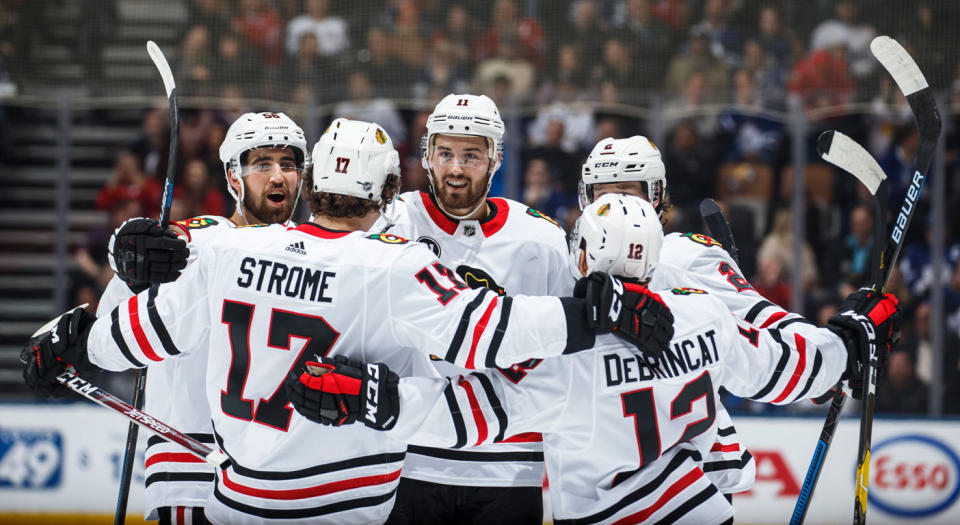How the Chicago Blackhawks became so explosive offensively
It’s no real secret that the Chicago Blackhawks have filled the net this season, but discovering that they’re riding a trajectory toward the team’s largest goal output across their stretch of dominance in the post-lockout era comes across as something of a surprise.
It’s that way, probably, because the uptick in Chicago’s production has moved in parallel with the significant scoring shift seen this season in the NHL and doesn’t immediately register when considering the most potent attacks in the league today. Ranked sixth and trailing league-leading Tampa Bay by 29 goals, in a vacuum Chicago’s scoring season doesn’t seem all that outstanding.
But when viewed in its historical context, and considering the fact that the Blackhawks had three championships seasons over the same time period, it certainly compares more favourably. Scoring 3.39 goals per game through 70 so far this season, the current Blackhawks are pacing their modern-day iterations and project to finish with a goal total that would challenge the top five most profitable scoring seasons in the last decade.
To trail several teams and still be on pace to challenge the historical benchmarks says something more about the health and explosiveness of the NHL right now than it does the Blackhawks, but it should not prevent us from celebrating a damn good, damn exciting team attack.

So how has Chicago, in the absence of a killer power play and independent of the league’s waves of increased scoring, seen its goal total swell?
Like it’s junior
Two moves of consequence this season have shaped the direction of the Blackhawks franchise: firing Joel Quenneville and trading for Dylan Strome.
While the transition under rookie coach Jeremy Colliton didn’t pay immediate dividends, the Blackhawks seemed to achieve some level of optimization the moment Strome was inserted into the lineup.
“It’s added this depth to our team,” veteran Chris Kunitz said of the addition of Strome. “Some guys have to get a fresh start to maybe change the path they were on. It’s exciting to see a guy that maybe was struggling to get into the league and find that offensive side he was supposed to have all along.”
In over 500 minutes shared with former junior roommate, best friend and second-year forward Alex DeBrincat across 46 games, the pair has been on the ice for a power play-enhanced ratio of 59 goals while pulling just 33 out of their own net. DeBrincat ranks second in goals and trails league-leader Leon Draisaitl by just one over that stretch, while Strome is contributing nearly a point per game after registering a measly seven goals and 16 points in 48 games across three seasons with the Arizona Coyotes.
Since Strome’s debut near the end of November, the renewed partnership has had direct presence for about one third of Chicago’s 167 goals — a total that represents the third-highest average output over the last 15 weeks behind just the Sharks and Lightning.
“The two of them have played great together, really changed and boosted our power play,” said Jonathan Toews. “They want to go out a create, they want to make plays, they want to learn and get better. I think it’s shown.”
“Just the familiarity they have with each other — they’re like brothers. They’re wrestling, and punching each other like really good friends (do),” Kunitz adds. “They are mature kids, obviously, but they bring youthfulness to our room.”
A key byproduct
Mining a talent like Strome to pair with the mega-talented DeBrincat was a move that solidified the Blackhawks’ top six forward group, but the implications from that transaction ran much deeper.
No longer forced to spread their existing talent across multiple lines with a legitimate scoring unit now driving results, the Blackhawks have been able to more prominently feature a top line with both Patrick Kane with Jonathan Toews. While combining the forces was usually reserved for desperate times, and never really seemed to work for prolonged stretches, the two have driven dominant results together and are each on pace for career-best seasons.
While it’s Kane submitted the MVP-worthy season, Toews seems to have benefitted the most from the opportunity. He’s eclipsed the 30-goal mark for the first time in eight seasons already, and looks poised to finish with over a point per game for the first time in a full 82-game season on the heels of his career-worst 2017-18 campaign.
“It’s amazing,” said Brandon Saad. “If you look statistically in the past, maybe they didn’t have their best success together, but this year for some season it stuck. Whether or not they have had that extra time to build that chemistry or not, it’s been pretty impressive to watch it come together.”
Colliton hasn’t featured his two $10-plus million players together exclusively since the addition of Strome, and has recently split them up, but the most time they have spent together this season has been the five weeks since the All-Star break. With Kane scoring at a top-five rate and Toews approaching the top 10 inside that window, the Blackhawks have produced at a staggering 4.32-goal nightly rate to lead the NHL.
“Any time you give negative criticism to superstars like that, they try to come out and change or (add) a new dynamic to their game,” Kunitz said, speaking to the approach from both stars this season.
“It’s crazy to say, but they have both been able to improve into their 30s by adding to their game. And they just challenge each other on the ice together, so that obviously helps too.”
The necessity thing
While you can’t score at a historically high level without talent, a pessimist could point to a less flattering reason for the Blackhawks’ production increase.
Only the Kings, Red Wings, Canucks, Senators and Devils — teams that hold five of the six worst records at this point — have spent more minutes trailing than the Blackhawks this season, and only one team has allowed more shots on their goaltenders.
“I’m sure our goalies would like to see us give up less than score more,” said Chris Kunitz.
Routinely chasing high-event games and working to balance out a historically-bad team defense, the Blackhawks are seldom in a position to lay off the gas pedal like they were on Wednesday in Toronto (which nearly cost them: don’t do this), and are instead most often committing resources toward waves of attack.
So as impressive as Chicago’s scoring increase has been, in some ways it’s been borne out of necessity.
More NHL coverage on Yahoo Sports:



